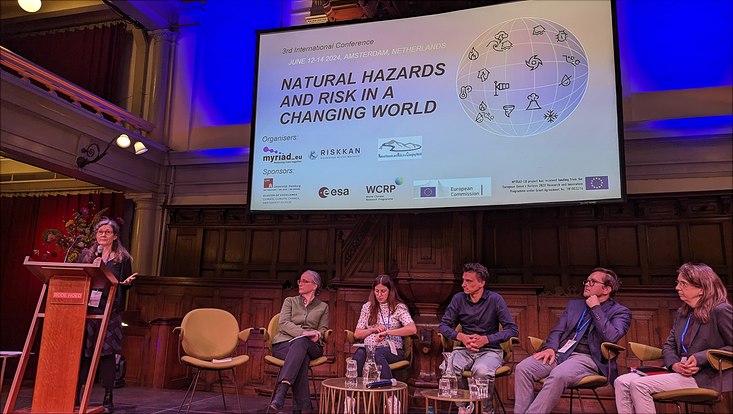Conference on Natural Hazards and RisksWeathering the Storm
17 June 2024, by Miriam Frieß

Photo: A. Vogelbacher, B. Poschlod, M. von Szombathely
This week, the third international Conference “Natural Hazards and Risks in a Changing World: Addressing Compound and Multi-Hazard Risk” took place in Amsterdam on June 12 and 13th. For two days, researchers, policy makers and stakeholders came together to discuss new developments and findings on the subject.
Risks through natural hazards do not exist in a vacuum. In a complex world, where everything is connected, a natural disaster also affects its surroundings and influences other systems, may it be other ecosystems, public health, infrastructure or farming. As our world changes, these risks undergo change as well, becoming more and more complex. That is why the projects and networks MYRIAD-EU, Risk KAN and NatRiskChange, which organized the event, focused on this circumstance and offered a platform for participants to discuss latest research and insights into risk research and experiences with risk management. The event opened with keynotes by four different experts, among them the European Commission Representative Dr. Juha-Pekka Jäpölä. In his keynote, he emphasized the importance of close and personal exchange between climate scientists and policy makers.
The Cluster of Excellence “Climate, Climatic Change, and Society” (CLICCS) sponsored the event and contributed to shape the content: CLICCS Professor Jana Sillmann not only co-organized the event but was also heavily involved during the convention. She chaired the panel discussion that followed the keynote speeches and hosted a session focusing on how to assess, model and ultimately manage systemic risk. In a poster session, she presented CLICCS research on global food security in the context of a changing climate.
Other CLICCS researchers were also involved in the event through, co-convening a session, presenting talks or posters. For instance, Dr. Benjamin Poschlod chaired a session on Dynamic drivers of risks and held a talk on hazards in Alpine Germany and the influence climate change may have on the region. He described the already acute situation and added, “future warming will lead to further intensification of sub-daily rainfall extremes and, therefore, adaptation measures must be designed accordingly.” CLICCS Senior Researcher Dr. Franziska S. Hanf also touched the subject of adaptation in her talk and presented modeling tools and diagrams that can be used to create a visual story of complex, multi-causal challenges.
The sometimes subtle, sometimes insistent tenor of the event was clear: Climate change is fueling already existing, highly enmeshed risks and demands for collective action. Accordingly, Jana Sillmann also calls for action, yet notes, “it’s our responsibility as scientists to embrace complexity and communicate it as opportunity to a wider solution space for adaptation and mitigation measures for climate-resilient and sustainable development.”
